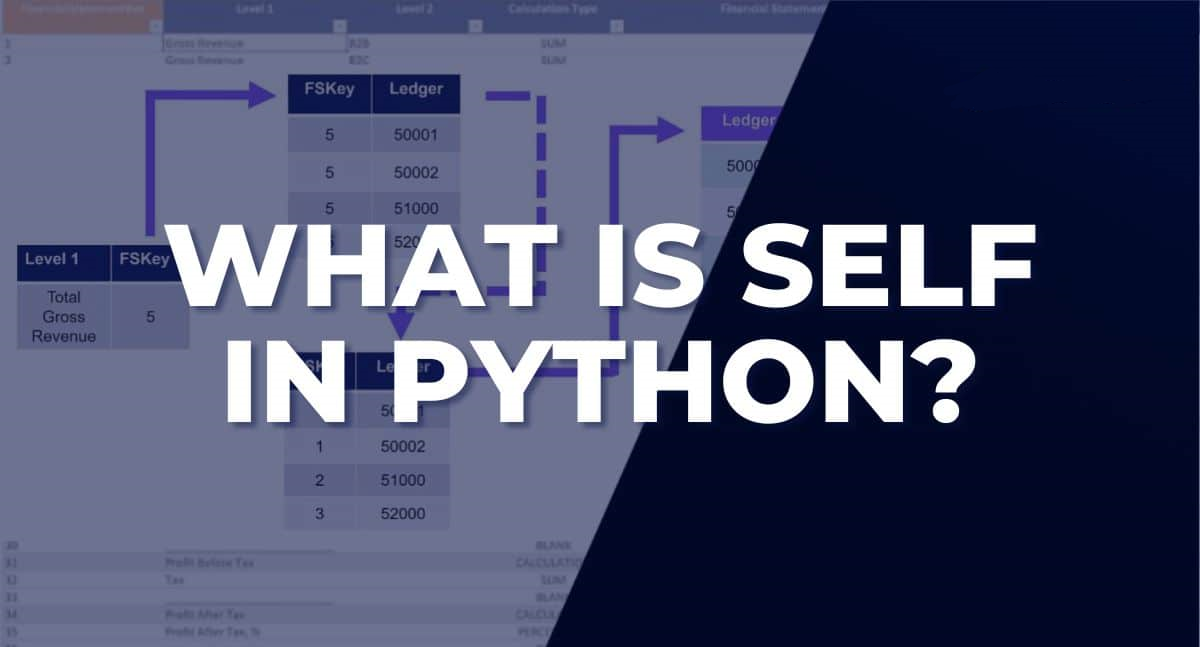Understanding Self in Python: The Key to Object-Oriented Programming
The world of programming is filled with objects, and Python’s object-oriented programming (OOP) approach allows you to create them in a structured way. But have you ever encountered the mysterious “self” lurking within your classes? This seemingly simple term is the key that unlocks the power of objects in Python.
“Self” acts as a bridge, connecting an object to its unique methods and attributes. Without it, your objects would be like isolated islands, unable to interact or perform actions. Understanding “self” empowers you to build dynamic and reusable code, making your Python programs more efficient and maintainable. So, buckle up as we delve into the world of “self” and unlock its secrets!
Demystifying “self”

The term “self” in Python might seem like a magic word used in class definitions, but fear not! It’s actually a straightforward concept that plays a crucial role in object-oriented programming. Here’s a breakdown to shed light on its purpose:
What is “self”?
- Definition: “Self” is a reference variable that points to the current object instance within a class. When you create an object from a class, Python automatically assigns this reference to the “self” variable inside the object’s methods.
- Not a Keyword: Unlike “def” or “if,” “self” is not a reserved keyword in Python. It’s a convention used by programmers to clearly indicate that a variable refers to the current object. This improves code readability and avoids confusion with other variables defined within methods.
When is “self” Used?
“Self” is primarily used inside instance methods, which are functions defined within a class. These methods operate on the data (attributes) associated with a specific object instance. Here’s why “self” is essential:
- Accessing Object Attributes: Within an instance method, you can access and modify the attributes of the current object using “self.” For example, if you have a
Dogclass with anameattribute, a method likebarkcould useself.nameto personalize the bark sound with the dog’s name. - Calling Other Object Methods: Similar to accessing attributes, “self” allows you to call other methods defined within the same class on the current object. This enables objects to interact with themselves and perform complex tasks.
In essence, “self” provides the bridge between an object and its internal workings. It allows methods to interact with the specific data and functionalities associated with each unique object instance.
Using “self” Effectively
“Self” becomes your trusty companion when working with objects in Python. Here’s how to leverage it effectively:
The __init__ method (constructor):
The __init__ method, also known as the constructor, is a special method that gets called automatically whenever you create a new object from a class. Its primary purpose is to initialize the object’s attributes with starting values.
Here’s the magic of “self” in action:
class Person:
def __init__(self, name, age):
self.name = name # Assigning values to object attributes using self
self.age = age
# Creating a Person object
person1 = Person("Alice", 30)In this example, the __init__ method takes two arguments (name and age) and assigns them to the object’s attributes using self.name and self.age. This way, each Person object you create will have its own unique name and age.
Instance methods:
Instance methods are the workhorses of your objects. They define the functionalities (actions) that objects can perform. Here’s how “self” empowers them:
- Operating on Object Data: Instance methods can access and manipulate the object’s attributes using “self.” This allows you to create methods that are specific to each object. For instance, a
Personclass could have agreetmethod that usesself.nameto personalize the greeting:
class Person:
# ... (constructor)
def greet(self):
print(f"Hello, my name is {self.name}!")
person1.greet() # Output: Hello, my name is Alice!- Modifying Object State: Methods can also modify the object’s state by updating its attributes. Imagine a
Petclass with afeedmethod that increases ahungerattribute:
class Pet:
# ... (constructor)
def feed(self):
self.hunger -= 1 # Decrease hunger level
# After playing, the pet gets hungry
pet.hunger = 5
pet.feed()
print(f"Pet's hunger level: {pet.hunger}") # Might output: Pet's hunger level: 4Accessing Class Attributes (with caution):
While primarily used for object attributes, “self” can also be used to access class attributes (shared by all object instances) with caution. However, it’s generally recommended to use the class name directly (e.g., Person.species = "Homo sapiens") for clarity and to avoid unintended modifications.
In rare cases, you might use self.__class__.__name__ to access the class name from within an instance method. This can be useful for dynamic behavior based on the object’s class type.
Common Pitfalls and Best Practices
Even seasoned Pythonistas can stumble with “self” sometimes. Here’s how to avoid common pitfalls and write clean, maintainable code:
Avoiding Confusion with Local Variables:
Within an instance method, you might define local variables with names similar to object attributes. This can lead to confusion about which variable is being accessed. Here’s how to prevent this:
- Meaningful Names: Always choose clear and descriptive names for your local variables. Avoid using names that directly conflict with object attributes.
- Using “self” Explicitly: If a variable name inside a method could be mistaken for an attribute, explicitly use
self.to access the object’s attribute. This clarifies your intent and avoids potential errors.
Importance of Consistent Naming Conventions:
While “self” is the standard convention, maintaining consistency throughout your codebase is crucial. Here are some tips:
- Always Use “self”: Don’t omit “self” from instance methods, even if it seems unnecessary at first. Consistency improves readability and reduces the risk of errors.
- Class-Specific Naming: Consider using a prefix for local variables within methods to differentiate them from object attributes. For example, use
self.namefor the object’s name andmethod_namefor a local variable within a method.
Why Using “self” Improves Code Readability:
Using “self” explicitly makes your code more readable for yourself and others. It clarifies that a method is operating on the current object instance. This is especially helpful when dealing with complex classes with many attributes and methods.
Here’s an example:
class Car:
def accelerate(self): # Clear: method operates on the current car object
# Increase speed attribute
def get_color(color): # Less clear: "color" could be a local variable or object attribute
# Access or modify color (uncertain)By consistently using “self,” you ensure that your code is clear and easy to understand, even when revisiting it later or collaborating with others.
Conclusion
Congratulations! You’ve navigated the world of “self” and unlocked the power of object-oriented programming in Python. Now it’s time to build something amazing! For a seamless development experience, consider partnering with ONextDigital. Our Web Development Service can transform your Python objects into stunning web applications, while our UX/UI Design Service ensures an intuitive and user-friendly experience. Imagine your objects coming to life as a sleek user interface or a powerful web application. Let ONextDigital be your guide as you translate your Python objects from code to a captivating user experience. Together, let’s bring your object-oriented vision to life! Contact us today.




